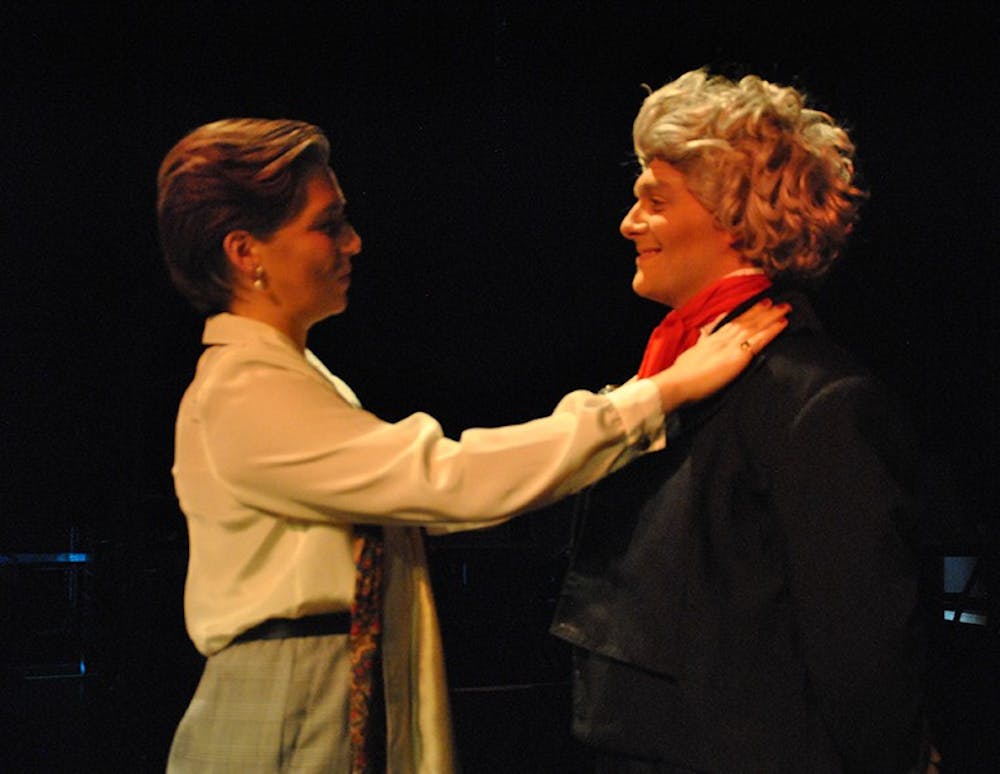There is beauty in a wrong turn down an unknown road, beauty in leaves crisped brown and crumpled into dust, beauty in a swirling black coffee — and according to “33 Variations,” there is beauty in a simple song and a flighty girl.
Performed by Shippensburg University students and directed by professor Paris Peet, “33 Variations” parallels the lives of composer Ludwig van Beethoven and his furor to create multiple variations of a simple waltz and a 21st century woman and her desire to discover what drove Beethoven to obsess over “mediocrity.”
Tyler Marshall played the childish, temperamental and genius Beethoven — creating a lovably comical character despite his antics, firing of staff and inability to pay his bills.
Marshall created a character that was enjoyable to watch on stage and a person who no one would ever actually want to meet in person.
Katherine Brandt, played by Alexandra Jones, wears an armor of controlled modesty and harsh judgments that can only be pierced by Beethoven and eventually, her daughter Clara, who is played by Abbie Bugh. The three storylines — a musician searching for the right note, a professor searching for an answer, and young woman searching for acceptance from her mother — weave effortlessly into a complex story of the beauty found in the most simple things.
What drew Peet to the play, he said, was Katherine’s rigid inability to understand that Beethoven saw beauty in a simple piece of music.
“Ultimately, it’s about what we’re inspired by and our ability to see what’s extraordinary in the ordinary,” Peet said.
Running out of time before Amyotrophic Lateral Sclerosis (ALS) takes over her body, Katherine travels to Bonn, Germany, in a desperate attempt to be as close to Beethoven as possible by studying the rough drafts of the scores that led to Beethoven’s “33 Variations.”
Jones’ execution of Katherine’s character, her disease and her desire for an answer, creates someone that is neither heroine nor villain, but human.
Jones portrays Katherine’s disease with subtle hand cramps and a twitching tongue throughout the play as constant reminders of the control Katherine is desperately fighting to maintain.
To care for her mother, Clara follows Katherine to Germany, despite Katherine’s adamant opinion that she does not need help or even a relationship with her daughter.
A chord of tension thrums between the mother and daughter because Katherine fears that Clara is coasting on a path of mediocrity. Through searching for her answer to Beethoven’s “33 Variations,” however, Katherine also finds beauty in her daughter.
Jones said that Katherine not only suffers from ALS, but also from an illness of ugliness that emerges in the way that she treats her daughter.
“Beauty often lies where we least expect it, and this play has taught me that ugliness lies most often in the people we love the most, but often that’s where beauty lies too,” Jones said.
Compared to the judgments that Katherine throws at Clara, her love for Beethoven’s music resonates in the way she describes the movement of the notes, her voice slipping into a smooth, warm beam of light and growing with strength with each crescendo.
As the play progresses, Katherine steps closer and closer to Beethoven until his hand is in hers and they are talking, despite the more than 200 year time difference. Having dealt with his hearing loss, Beethoven helps Katherine with her own sickness and eventually her death in dream-like sequences where the two characters are connected by the music that drives them both.
However, Katherine dies knowing that her presumptions of beauty were wrong and with an understanding of what determines true beauty.
Toward the end of her sickness, Katherine interrupts Clara as she hums a melody.
Katherine demands to know what she is singing, already knowing the answer but incredulous that it could be true — Clara was humming the simple melody that Beethoven derived his variations from.
“Why would she sing this,” Katherine asks her daughter.
“Because it is pretty and it is nice to dance to,” Clara answers.
It is then that Katherine realizes that she completely misunderstood Beethoven because he thought the song was beautiful and that is why he dedicated so many years to creating “33 Variations.”
He was not mocking the simple waltz — he was celebrating its beauty by exploiting its many forms.
Through this unfolds a more important discovery — Katherine’s perception of Clara. Finally, Katherine can see her daughter exactly for who she is and from within that, see beauty.


The Slate welcomes thoughtful discussion on all of our stories, but please keep comments civil and on-topic. Read our full guidelines here.